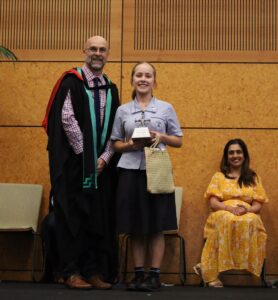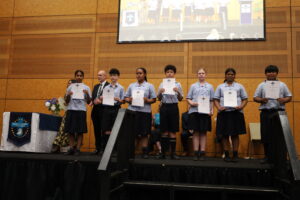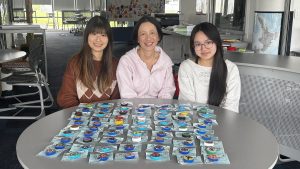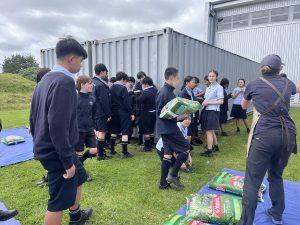In March 2025, Joshua De Guzman left the classroom behind, bound for the Sub-Antarctic Islands. Aboard the HMNZS Canterbury, he embarked on a rare expedition grounded in science, service, and guardianship. Over twelve days, from 1- 12 March, he joined a select cohort supported by BLAKE Expeditions, the New Zealand Defence Force, and the Department of Conservation, representing Sancta Maria College as both a student leader and an emerging voice in youth conservation. Joshua entered a landscape where isolation amplifies fragility, and where every action taken—every sample logged, every footprint considered—carried meaning far beyond the moment.
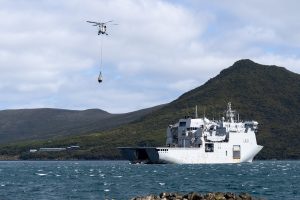
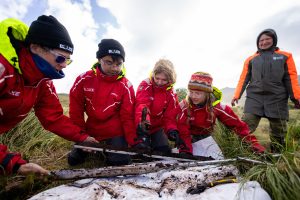
Later, Joshua collaborated with Dr. Gary Wilson, professor of marine geology and Deputy Vice-Chancellor at the University of Waikato, on high-altitude rock sampling along the ridges of Mount Lyall. These rock samples would later be carbon dated and examined for cosmogenic isotopes – traces of galactic radiation exposure – to determine when the region last emerged from glacial cover, contributing to a broader understanding of Southern Hemisphere glacier retreat. Though he was unable to join Dr. Phoebe Chapman from the University of Otago on marine kelp monitoring, Joshua gained valuable insight into the interconnectedness of these projects: a collective scientific effort aimed at better understanding climate systems and guiding global responses to environmental change.
This scientific expedition was further enriched by interdisciplinary collaboration. The Defence Science and Technology Group worked alongside the University of Auckland to test synthetic aperture radar (SAR4SAR) for search and rescue applications, deploying reflectors and collecting oceanographic data to assess their effectiveness in one of the most challenging maritime environments on Earth. Meteorologists from MetService contributed atmospheric modelling, while members of Ngāi Tahu shared their deep ancestral connections to the land—offering insight into traditional knowledge systems, ecological stewardship, and the selective breeding of native plants for medicinal and commercial use. Sailing ashore aboard ZODIACs and RHIBs, surrounded by albatross, sea lions, and resilient megaherbs, Joshua found himself immersed in a world far removed from the streets of Auckland. The stark contrast between urban routine and the isolated intensity of these islands left a lasting impression. On his final day on Campbell Island, he completed his first-ever 6.33km hike to Northwest Bay, battling relentless sub-Antarctic winds—a moment of both physical challenge and quiet reflection, surrounded by ancient landscapes shaped by rain, sea, and time.
A distinctive aspect of the expedition was the opportunity to work alongside the New Zealand Defence Force – an experience that offered a powerful lesson in unity and discipline. Their commitment to Kotahitanga, a collective approach rooted in solidarity (combined with their logistical precision) created a unique perspective on environmental action. Through their support in navigating harsh terrain, launching ZODIACs, and ensuring the safety of all personnel, Joshua witnessed how military coordination can be harnessed for peaceful, purposeful missions that uphold environmental protection. It was a reminder that conservation is not confined to one profession or ideology, it thrives when diverse groups come together in pursuit of a shared goal.
Yet the expedition was not without reminders of the work still to be done. Despite their remoteness, the Sub-Antarctic Islands are not immune to the scars of human impact—particularly the legacy of invasive species. Many of the ecosystems Joshua encountered, though remarkably intact, remain vulnerable to pests that can devastate native flora and fauna already under pressure from climate change. Efforts to eradicate these threats are ongoing, but the fight is far from over. As he saw the care and urgency behind pest monitoring on the islands, Joshua was reminded of the parallels with his own efforts back home. At Sancta Maria College, he helps lead the Kaitiaki Network, a student-led environmental team committed to pest plant removal and trapline maintenance in local reserves. That shared sense of vigilance—whether in the windswept ridges of Motu Ihupuku or the bush corridors of Auckland—reinforced for him that environmental stewardship is a continuous, collective effort, grounded in both global awareness and local action.
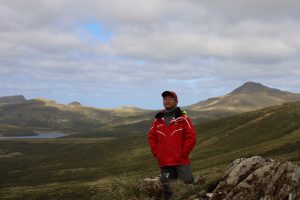
Special thanks to: Sir Peter Blake Foundation, NZDF, Department of Conservation, teachers Dr. Laux, Ms. Bracey and Mrs. Al-Rubaie, Auckland Council and the HMNZS Canterbury.
An additional special credit to BLAKE Expeditions and Josh Chapman @joshchaps_snaps for all the photography (simply amazing) and Joshua De Guzman for sharing his journey with us.
Here is a short video, curtesy of BLAKE Expeditions: https://www.youtube.com/watch?v=AzADouo83KY


